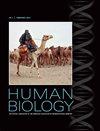中国新疆古代儿童头骨随年龄增长的尺寸变化
4区 生物学
Q2 Medicine
引用次数: 0
摘要
许多学者对儿童头骨在头颅大小、头围、颅腔容积等方面的生长规律进行了研究。本研究比较分析了中国新疆扎尕那鲁克墓地 38 名儿童(2-15 岁)和 87 名成年女性(20-40 岁)头骨中不同年龄段的 20 项头骨测量指标,以确定古代儿童头骨大小随年龄的变化情况。方差分析(ANOVA)显示,六个年龄组(2 岁、3-5 岁、6-8 岁、9-11 岁、12-15 岁和成人[20-40 岁])在头骨的度量特征、头骨面积和颅腔容积方面存在显著差异。结果表明,3-5 岁、12-15 岁和成人的头骨一直在增长,这意味着新疆古代儿童的头骨尺寸随着年龄的增长而不断增大。此外,研究还发现 12-15 岁儿童的头骨明显小于成人。这一发现表明,新疆古代儿童的头骨在 15 岁时尚未发育完全。值得注意的是,不同年龄段的儿童在头骨发育特征和头骨变化速度方面都存在差异。本文章由计算机程序翻译,如有差异,请以英文原文为准。
Dimensional Changes in the Skulls of Ancient Children with
Age in Xinjiang, China
Many scholars have conducted research on the growth patterns of children’s skulls in terms of skull
size, head circumference, cranial cavity volume, and so forth. This study compared and analyzed 20
skull measurement indexes of different ages from skulls of 38 children (aged 2–15 years) and 87 adult
females (20–40 years) at the Zaghunluq cemetery in Xinjiang, China, to determine how the size of ancient
children’s skulls changed with age. Analysis of variance (ANOVA) showed significant differences between
the six age groups (2, 3–5, 6–8, 9–11, 12–15 years, and adults [20–40 years]) in terms of metrical cranial
traits, cranial area, and cranial cavity volume. Results indicate that the skull kept growing from ages 3–5,
12–15, and adults, implying that the skull sizes of ancient children in Xinjiang continued to increase with
age. In addition, the study revealed that children aged 12–15 had skulls that were significantly smaller
than those of adults. This finding showed that the skulls of ancient children in Xinjiang were not fully
developed at the age of 15. Notably, differences existed between age groups in both developmental traits
of the cranium and the rates at which the skull changed.
求助全文
通过发布文献求助,成功后即可免费获取论文全文。
去求助
来源期刊

Human Biology
生物-生物学
CiteScore
1.90
自引率
0.00%
发文量
88
审稿时长
>12 weeks
期刊介绍:
Human Biology publishes original scientific articles, brief communications, letters to the editor, and review articles on the general topic of biological anthropology. Our main focus is understanding human biological variation and human evolution through a broad range of approaches.
We encourage investigators to submit any study on human biological diversity presented from an evolutionary or adaptive perspective. Priority will be given to interdisciplinary studies that seek to better explain the interaction between cultural processes and biological processes in our evolution. Methodological papers are also encouraged. Any computational approach intended to summarize cultural variation is encouraged. Studies that are essentially descriptive or concern only a limited geographic area are acceptable only when they have a wider relevance to understanding human biological variation.
Manuscripts may cover any of the following disciplines, once the anthropological focus is apparent: human population genetics, evolutionary and genetic demography, quantitative genetics, evolutionary biology, ancient DNA studies, biological diversity interpreted in terms of adaptation (biometry, physical anthropology), and interdisciplinary research linking biological and cultural diversity (inferred from linguistic variability, ethnological diversity, archaeological evidence, etc.).
 求助内容:
求助内容: 应助结果提醒方式:
应助结果提醒方式:


